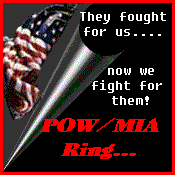 BLACK, COLE Name: Cole Black Rank/Branch: O4/US Navy Unit: Date of Birth: 23 November 32 Home City of Record: Lake City MN Date of Loss: 21 June 1966 Country of Loss: North Vietnam Loss Coordinates: 213400N 1063900E (XJ708855) Status (in 1973): Released Prisoner Of War Category: Aircraft/Vehicle/Ground: F8E Other Personnel in Incident: (none missing) Source: Compiled by Homecoming II Project from one or more of the following: raw data from U.S. Government agency sources, correspondence with POW/MIA families, published sources, interviews. Updated by the P.O.W. NETWORK. REMARKS: 730212 RELSD BY DRV SYNOPSIS: The Vought F8 "Crusader" saw action early in U.S. involvement in Southeast Asia. Its fighter models participated both in the first Gulf of Tonkin reprisal in August 1964 and in the myriad attacks against North Vietnam during Operation Rolling Thunder. The Crusader was used exclusively by the Navy and Marine air wings (although there is one U.S. Air Force pilot reported shot down on an F8) and represented half or more of the carrier fighters in the Gulf of Tonkin during the first four years of the war. The aircraft was credited with nearly 53% of MiG kills in Vietnam. The most frequently used fighter versions of the Crusader in Vietnam were the C, D, and E models although the H and J were also used. The Charlie carried only Sidewinders on fuselage racks, and were assigned such missions as CAP (Combat Air Patrol), flying at higher altitudes. The Echo model had a heavier reinforced wing able to carry extra Sidewinders or bombs, and were used to attack ground targets, giving it increased vulnerability. The Echo version launched with less fuel, to accommodate the larger bomb store, and frequently arrived back at ship low on fuel. The RF models were equipped for photo reconnaissance. The combat attrition rate of the Crusader was comparable to similar fighters. Between 1964 to 1972, eighty-three Crusaders were either lost or destroyed by enemy fire. Another 109 required major rebuilding. 145 Crusader pilots were recovered; 57 were not. Twenty of these pilots were captured and released. The other 43 remained missing at the end of the war. Commander Cole Black was the pilot of an F8E sent on a combat mission over North Vietnam on June 21, 1966. His flight route took him northeast of Hanoi, where he was shot down near the border of Lang Son and Ha Bac Provinces about 15 miles southwest of the city of Lang Son. For the next 7 years, Black was held in various prisoner of war camps, including the infamous "Hanoi Hilton" complex in Hanoi. He was released in the general prisoner release in 1973. Since the war ended, nearly 10,000 reports relating to Americans missing, prisoner or unaccounted for in Southeast Asia have been received by the U.S. Government. Many authorities who have examined this largely classified information are convinced that hundreds of Americans are still held captive today. These reports are the source of serious distress to many returned American prisoners. They had a code that no one could honorably return unless all of the prisoners returned. Not only that code of honor, but the honor of our country is at stake as long as even one man remains unjustly held. It's time we brought our men home. SOURCE: WE CAME HOME copyright 1977 Captain and Mrs. Frederic A Wyatt (USNR Ret), Barbara Powers Wyatt, Editor P.O.W. Publications, 10250 Moorpark St., Toluca Lake, CA 91602 Text is reproduced as found in the original publication (including date and spelling errors). UPDATE - 09/95 by the P.O.W. NETWORK, Skidmore, MO
After completing the officers candidate school at Newport Rhode Island I was given a commission. I attended flight training and won my wings of gold in February 1957. I then became a reccee (reconnaissance) pilot and spent four years with Light Photographic Squadron 62 based at Cecil Field Florida. After leaving that squadron in 1961 I attended the U.S. Naval Postgraduate School at Monterey California where I received my B.S. degree in 1964. The war in Vietnam was getting started and after leaving Monterey I was assigned to Fighter- Squadron 211 based at Miramar California. I had completed one combat cruise in Southeast Asia and had only seven days left on my second cruise when I was shot down. I was shot down on 21 June 1966 while flying an F8E of Fighter Squadron 211 based aboard the attack carrier Hancock. I was shot down north of Hanoi near Kep airfield. I ejected from my disabled fighter at a very low altitude and was captured by some Vietnamese peasants very shortly after I hit the ground. The peasants did not treat me too badly. However, I was soon in the hands of the VPA. On the way to Hanoi I was put on display for the local people. Some of them were very hostile, others just curious. When I arrived at Hanoi I was treated like an animal. The communists call it "reducing you to a dog." Perhaps that is a good analogy because when they get done with you, you are unable to use your hands and have to do things, such as eating, like a dog. Soon after I arrived in Hanoi, on July 6, 1966, the communists saw fit to display American POWs in Hanoi. We were hauled down town and forced to walk through the streets of Hanoi while the local population humiliated, beat and tried to intimidate us. It was probably the most real demonstration of mob action I have or ever will see. I believe that even with the vice-like grip the communists have on their people, the people nearly got out of hand that night. In my opinion they were so keyed up they would have liked to have killed us all. During my tour in prison, I can say that I have come to know some of the greatest guys in the world. We have known humiliation together; we have known compassion together; we have suffered together and now that we are home we once again, know the joy of being free and being in our great country. For me the thoughts of returning to America and to loved ones inspired me throughout my captivity. Even when you seem to be losing all else no one can take away the precious memories you may have of the loved ones you left behind, the joys you knew as a boy, the beauty of the country you will one day return to, and all the kind things your father and mother have done for you. I am very happy to be back and I feel very lucky to be here. I hope to stay in the Air Force and serve my country once again. November 1996 Cole Black retired from the United States Navy as a Captain. He and his wife Karen live in California.
 
|


